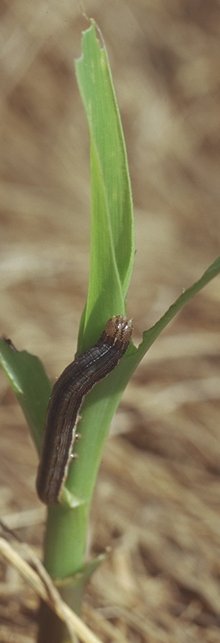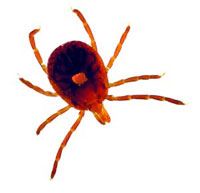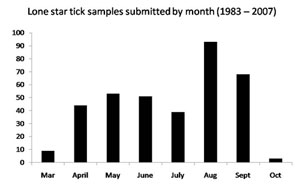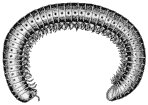

GREEN JUNE BEETLES and JAPANESE BEETLES cruising over turf;
TWO-SPOTTED SPIDER MITES on vegetables and ornamentals;
second generation EUROPEAN CORN BORER;
WESTERN CORN ROOTWORM BEETLES feeding on corn silks;
second generation of COLORADO POTATO BEETLE;
DOGWOOD sawflies feeding on dogwoods;
BLISTER BEETLES feeding in gardens;
wandering MILLIPEDES in homes;
BLISTER BEETLES feeding in home gardens;
DOGDAY or ANNUAL CICADAS emerging.


 Armyworm flight for the second generation is in progress. Moth captures in Princeton are not very large but captures in Lexington are quite large. There are also reports of large armyworm moth flights all the way into Canada. The large number of moths in this second generation is not unexpected given the large first generation flight and the resulting number of economically important caterpillar infestations.
Armyworm flight for the second generation is in progress. Moth captures in Princeton are not very large but captures in Lexington are quite large. There are also reports of large armyworm moth flights all the way into Canada. The large number of moths in this second generation is not unexpected given the large first generation flight and the resulting number of economically important caterpillar infestations.
I do not expect damaging armyworm caterpillar populations from this second generation moth flight. I do not know of any time in the last 28 years that a second generation armyworm flight has developed into a damaging population in our crops. Generally, our crops that armyworms attack are not in a susceptible stage during the second generation. It is also likely that these pests are feeding on non-crop host plants.
Producers should be on the watch for the fall armyworm (FAW). This is NOT the same insect as armyworm. FAW trap captures in the Princeton have significantly increased over the last week. FAW is most often a pest on late planted corn, where it can be very difficult to control and may cause considerable damage. Corn planted during the recommended plating period is rarely damaged. Very late-planted corn, and corn that was replanted could be at risk. Additionally, FAW are generally more of a problem in the south and western portions of our corn production area as opposed to the north and east.
FAW larvae vary from light tan to nearly black with three thin light yellow lines down the back. There is a wider dark strip and a wavy yellow red-splotched stripe down each side. They resemble both armyworm and corn earworm but FAW have a prominent white inverted Y mark on the front of the head.
The key to FAW management is avoidance (proper planting date) and if late planting is required, early detection. Early FAW feeding on corn looks much like European corn borer feeding (window pane type damage", and the caterpillars are found in similar situation in the plant. Controlling FAW when they are small and in the upper portion of the plant whorl is much more successful than when the caterpillars are larger and deeper into the whorl.
FAW can be very difficult to control because it tends to "burrow" into the center of the whorl with its head down. Because the "burrowing" is done by feeding, the caterpillars also produce excrement (politely call frass) that builds up behind them and serves as a "plug" which prevents insecticide from reaching the insect.
If insecticidal control is required, you may find a list of products registered for FAW on corn in
Insecticide Recommendations for Corn - 2008. You can obtain this publication form your local
County Extension office or on line at:
http://pest.ca.uky.edu/EXT/Recs/welcomerecs.html. For additionally information on FAW see
Entfact - 110 Fall Armyworm in Corn at:
http://www.ca.uky.edu/entomology/dept/entfacts.asp


 As of July 14, 2008 we remain blue mold-free in Kentucky. Pennsylvania was added on July 12 to the list of states reporting blue mold; other states include GA, FL, and VA. Blue mold poses a minimal threat to KY for now. Current forecasts indicate that inoculum from known sources of blue mold did not move into our area during the past week, and likely will not threaten us for the first few days of the current week. We do have active sources in the Deep South and now PA, so continued monitoring our crops in the field for signs and symptoms of blue mold is the best advice. The weather for the week of July 14 will be increasingly warm and sunny. These conditions should be unfavorable for development of blue mold should inoculum be introduced into the region.
As of July 14, 2008 we remain blue mold-free in Kentucky. Pennsylvania was added on July 12 to the list of states reporting blue mold; other states include GA, FL, and VA. Blue mold poses a minimal threat to KY for now. Current forecasts indicate that inoculum from known sources of blue mold did not move into our area during the past week, and likely will not threaten us for the first few days of the current week. We do have active sources in the Deep South and now PA, so continued monitoring our crops in the field for signs and symptoms of blue mold is the best advice. The weather for the week of July 14 will be increasingly warm and sunny. These conditions should be unfavorable for development of blue mold should inoculum be introduced into the region.
For the latest blue mold status and other tobacco disease information, check the KY Blue Mold Warning System online.
![]() http://www.uky.edu/Agriculture/kpn/kyblue/kyblue.htm
http://www.uky.edu/Agriculture/kpn/kyblue/kyblue.htm

For more information about tobacco pests, visit "Insect Management Recommendations".

 Corn rootworm beetles have emerged from the soil and are now feeding in corn. While western corn rootworm has not been a significant problem for many corn fields in Kentucky because of the crop rotation typically employed throughout much of the state, high grain prices have increased the number of continuous corn fields and contributed to an increase in the rootworm population. During this midsummer period, growers need to evaluate rootworm levels in their corn field to determine the needed for rootworm management in 2009 and if rootworms might interfere with corn pollination this year.
Corn rootworm beetles have emerged from the soil and are now feeding in corn. While western corn rootworm has not been a significant problem for many corn fields in Kentucky because of the crop rotation typically employed throughout much of the state, high grain prices have increased the number of continuous corn fields and contributed to an increase in the rootworm population. During this midsummer period, growers need to evaluate rootworm levels in their corn field to determine the needed for rootworm management in 2009 and if rootworms might interfere with corn pollination this year.
Rootworm beetles will feed on the upper leaf surface of upper leaves, particularly near the leaf tips. They also feed on the fresh ear silks as they emerge. With some corn planted later this season, there is the risk of large numbers of rootworm beetles clipping these silks prior to pollen shed. This may result in poor ear pollination and barren areas on the ear. If rootworm beetles have clipped the silks back to less than ½ inch prior to pollen shed, then growers need to consider treating fields for the beetles. Last year, fields in several counties required treatment to prevent pollination interference.
The striped western corn rootworm and the green northern corn rootworm beetles lay their eggs in mid summer at the base of corn plants. The soybean variant of the western corn rootworm that lays its eggs in the soil of soybean fields has not been found in Kentucky. By monitoring the level of rootworm beetles this summer in specific corn fields, growers can determine the need for rootworm management if these same fields are kept in corn in 2009. The threshold for rootworm beetles is an average of one rootworm beetle per plant at any time during the mid summer. If this threshold is exceeded then growers have several options, they can plant a non-corn crop in those fields, use a soil applied insecticide at planting, use a corn rootworm seed treatment, or use a Bt corn that provides corn rootworm protection.
For information about corn pests, visit
"Insect Management Recommendations".


 The mid July period is when grape root borer emerges and lays eggs. While the grape root borer has been relatively uncommon in Kentucky's vineyards, this insect has the potential to severely reduce the health of vines even to the point of killing them. The large cream colored larva of the grape root borer has a two year life cycle feeding in the crown and roots of the plant below the soil surface.
The mid July period is when grape root borer emerges and lays eggs. While the grape root borer has been relatively uncommon in Kentucky's vineyards, this insect has the potential to severely reduce the health of vines even to the point of killing them. The large cream colored larva of the grape root borer has a two year life cycle feeding in the crown and roots of the plant below the soil surface.
The grape root borer moth begins to emerge from the soil in early July, mates, and lays eggs on the lower years of grapes and other weeds. While the moth belongs to the family of 'clearwing' moths, this species has dork brown wings and is a paper wasp mimic. Unlike many moths, the grape borer moth is active during the day and may be seen flying through the vineyard during the day and resting on leaves. During mid July, grape growers should examine around the bases of the vines to determine the level of rootworm emergence. Growers need to look for the empty pupal cases partially protruding from the soil. The cases are about 1-1/2 inch and translucent brown. If more than 5 % of the vines are found to have these pupal cases, then growers are advised to apply an application of Lorsban to the soil around the base of the vines in 2009. Lorsban can only be applied to the soil (not the foliage) and it has a 35-day pre harvest interval. It may be applied around vines in 2008 if these is at least 35 days until harvest.



 The lone star tick is an important pest of humans, pets, and wildlife in western and southern Kentucky and is becoming more common in central and eastern counties. The species gets it common name from a distinct white spot on the back of the adult female. Adult males do not have this spot; instead, they have pale, lacy white markings on the rear edge of the back. Each of the three active stages (larva, nymph, and adult) will feed on humans from spring to fall. Lone star ticks have long mouthparts which can penetrate deeply into the skin, making them difficult to remove. Tick bites can be very irritating and the bite site may become infected if it is scratched frequently and contaminated.
The lone star tick is an important pest of humans, pets, and wildlife in western and southern Kentucky and is becoming more common in central and eastern counties. The species gets it common name from a distinct white spot on the back of the adult female. Adult males do not have this spot; instead, they have pale, lacy white markings on the rear edge of the back. Each of the three active stages (larva, nymph, and adult) will feed on humans from spring to fall. Lone star ticks have long mouthparts which can penetrate deeply into the skin, making them difficult to remove. Tick bites can be very irritating and the bite site may become infected if it is scratched frequently and contaminated.
Based on specimens sent to the Insect Identification Labs at Lexington and Princeton, lone star ticks are most active in Kentucky from April through September. Most larvae and nymphs, the smaller stages of the tick, are received during this time. Female ticks lay large numbers of eggs in a mass. Severe infestations occur when someone moves through or lingers in a area where hundreds of freckle-sized hungry larvae (seed ticks) are waiting for a meal.
Lone Star Ticks and Disease
The lone star tick is not known to carry Lyme disease but its associations with a condition called Southern Tick Associated Rash Illness (STARI) and human ehrlichiosis are being investigated. As a precaution, report any flu-like symptoms within 2 weeks of a bite or known exposure to any tick to your physician. Ticks can be preserved for identification in a small jar containing rubbing alcohol. There are no agencies in Kentucky that test ticks for diseases.
Here are some things to do to reduce the possibility of being bitten by ticks when in infested areas.


Rust disease is showing up on Kentucky bluegrass early this season (and rather severely in some locations in central Kentucky), and it may be showing up on perennial ryegrass and other cool-season grasses as well. The generally mild and wet weather this summer has been very favorable for rust development. The disease is readily recognizable in the field from its tiny, orangish pustules of powdery spores that erupt from within the leaf blade, eventually causing leaf blades to turn yellow and dry up. The disease does not kill turf outright but can weaken it if severe.
Under Kentucky conditions, these leaf rusts of turfgrasses usually are significant problems only in swards that are growing slowly, such as those that are low in nitrogen or low in soil moisture. Maintenance of adequate soil moisture and autumn fertilization are the principal management practices suggested. For particularly high- value swards where there may be interest in spraying fungicides, the most effective products are those that contain azoxystrobin, propiconazole, triadimefon, pyraclostrobin, mancozeb or chlorothalonil (but note that several years ago chlorothalonil lost its label for use on residential lawns).

 Millipedes are long, many segmented creatures that use their two pairs of legs per body segment to move with deliberate determination. There are several species in Kentucky so we can see a variety of shapes and colors. Millipedes can be very abundant in forest litter, grass, thatch, and in mulched areas. These places provide them with the food and dampness that they prefer. Usually, millipedes stay out of sight unless abundant rainfall or some other event, such as the mating season, puts them on the move.
Millipedes are long, many segmented creatures that use their two pairs of legs per body segment to move with deliberate determination. There are several species in Kentucky so we can see a variety of shapes and colors. Millipedes can be very abundant in forest litter, grass, thatch, and in mulched areas. These places provide them with the food and dampness that they prefer. Usually, millipedes stay out of sight unless abundant rainfall or some other event, such as the mating season, puts them on the move.
While harmless and in fact, helpful recyclers, millipedes generally are not welcomed with enthusiasm. They often invade crawl spaces, damp basements and first floors of houses at ground level. Common points of entry include door thresholds (especially at the base of sliding glass doors), expansion joints, and through the voids of concrete block walls. Frequent sightings of these pests indoors usually mean that there are large numbers breeding on the outside in the lawn, or beneath mulch, leaf litter or debris close to the foundation. Because of their moisture requirement, they do not survive indoors more than a few days unless there are very moist or damp conditions.
MILLIPEDE MANAGEMENT


During the past week, the PDDL received samples of black shank, AMV, TSWV, Fusarium wilt, and manganese toxicity on tobacco; Phytophthora root/ stem rot and potassium deficiency on soybean; and bacterial stalk rot on corn.
On fruits and vegetables, we diagnosed anthracnose and downy mildew on grape; fire blight on apple; brown rot on apricot; bacterial leaf spot on peach; bacterial soft rot, and stinkbug injury on sweet corn; anthracnose, Fusarium wilt and bacterial wilt on cantaloupe; pollination problems on a variety of cucurbits; AMV on pepper; BCMV on bean; Rhizoctonia root/ stem rot on potato; and bacterial spot, Septoria leaf spot, early blight and Fusarium wilt on tomato.
On ornamentals and turf, we have seen scab on crabapple; Fusarium crown rot and Pythium root rot on petunia; Cercospora leaf spot on hollyhock; cedar/ quince rust on hawthorn; Phytophthora collar rot on ornamental peach; brown spot on Austrian pine; powdery mildew on sycamore; brown patch on fescue; and smut on bermudagrass.


July 4-11, 2008
UKREC-Princeton, KY
| Black Cutworm
| 18
| True Armyworm
| 91
| Corn Earworm
| 50
| European Corn Borer
| 0
| Southwestern Corn Borer
| 3
| Fall armyworm
| 2
| | |
Lexington, KY
| Black Cutworm
| 19
| True Armyworm
| 1707
| Corn Earworm
| 21
| European Corn Borer
| 2
| Southwestern Corn Borer
| 0
| Fall armyworm
| 0
| | |
Graphs of insect trap counts are available on the IPM web site at - http://www.uky.edu/Ag/IPM/ipm.htm. View trap counts for Fulton County, Kentucky at - http://ces.ca.uky.edu/fulton/anr/
NOTE: Trade names are used to simplify the information presented in this newsletter. No endorsement by the Cooperative Extension Service is intended, nor is criticism implied of similar products that are not named.
Lee Townsend
Extension Entomologist